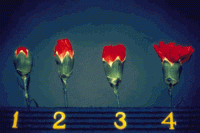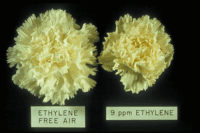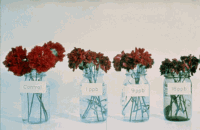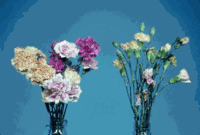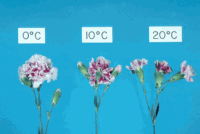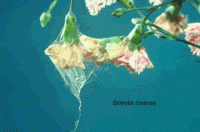Maturity and Quality
To minimize the spread of disease, avoid harvesting from plants with obvious disease symptoms. Many pickers place cut flowers on the top of wires for later collection into bunches. Flowers collected into canvas slings can be taken to the shed by mechanical devices ranging from overhead cables to tractor-hauled trailers designed to hold the slings. Standard carnations ship better and last longer if purchased in the bud stage while miniature carnations should be purchased when at least one flower per stem is open. Fragrant cultivars have more consumer appeal.
The maturity at which carnations are harvested depends on the proposed marketing procedure. Star-stage buds are too immature for most purposes except long-term storage. Buds at the ‘paint-brush’ stage, with petals straight up, will open quickly. Flowers for immediate use are normally harvested with the outer petals between vertical and horizontal.
Grading and Bunching. Both standard and miniature carnations are graded by stem strength, stem length, bloom diameter, and freedom from defects. Stem strength is determined by holding the stem horizontally at a point one inch above the minimum length for the grade. If the deviation of the flower head is more than 30° from the horizontal (with the natural curvature down), the flower is considered defective. Other defects include slab sides, bullheads, blown heads, singles, sleepy appearance, splits, discoloration, and damage from insects and diseases. Standard carnations are bunched, and tied at the base and at least one other place below the flower heads. Instead of different colored labels, some growers indicate different grades by the color and/or number of rubber bands on each bunch. Standards for miniature carnation bunches vary; a bunch normally contains a minimum of 30 buds total, at least 7 of which are open. With standard carnations, flower heads may be alternated (5 high, 5 low) at the top of the bunch to produce a neat and compact bunch and reduce the risk of neck breakage.
Postharvest Handling and Storage
Carnations should be stored at 0-1°C. Bud-harvested flowers perform best in storage because they are less sensitive to ethylene than mature flowers. Flowers or buds for storage should be of the highest quality and absolutely free of pests and diseases. They should be treated with 1-MCP or STS and a fungicide for Botrytis control then packed in a box lined with polyethylene and newspaper. Open flowers can be stored 2 to 4 weeks, while bud-cut flowers can be safely stored up to 4 or 5 weeks. There are methods available for storing buds for up to four months.
Carnations are ethylene sensitive and exposure to ethylene causes premature petal wilting (referred to as ‘sleepiness’). Some of the newer cultivars are less sensitive to ethylene than the standard ‘Sim’ types, and carnations have now been genetically modified by the addition of a mutation of the ethylene binding site that makes them insensitive to ethylene.
Pretreatments
Carnation flowers must be pre-treated with 1-MCP or STS. Research shows that the effectiveness of 1-MCP is lost within a week at room temperature, but is retained for extended periods when carnations are held at low temperatures. Pulsing the treated flowers overnight with a preservative containing 10% sucrose improves flower opening and quality carnation buds can be opened, at room temperature and under normal room lighting, in a solution containing 7% sucrose and 200 ppm Physan®. The buds should have been treated, first, with 1-MCP or STS.
Temperature & Controlled Atmosphere Photos
|
Title: Ethylene Effects (1) Photo Credit: Michael Reid, UC Davis |
Title: Ethylene Effects (2) Photo Credit: Michael Reid, UC Davis |
Title: Ethylene Effects (3) Photo Credit: Michael Reid, UC Davis |
Title: Temperature Effects Photo Credit: Michael Reid, UC Davis |
Packing
Carnations are usually packed in standard horizontal fiberboard boxes.
Special Considerations
Spray carnations do not always respond well to STS because the different flower maturities do not take up the STS solution equally. While it is difficult to recognize water-stressed carnations, a severe reduction in vase life is the result, so keep them hydrated when held above 0-1ºC.
Description
Dianthus caryophyllus. Long one of the most important of the commercial cut flowers, the carnation has benefited enormously from the use of STS, which can increase its vase life two to threefold. The wide range of colors and forms, especially for miniatures, allows florists and consumers to use and enjoy them in many ways. The genus name, Dianthus, derives from the Greek for ‘flower of love’. Carnations used to be called ‘clove gilly-flowers’ in reference to their intense clove-like aroma. Some modern cultivars are very fragrant and are used to make perfumes. Carnations can be stored longer than any other flower and can be opened to high quality flowers from very tight buds. Miniature carnations are also referred to as spray carnations.


